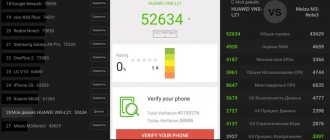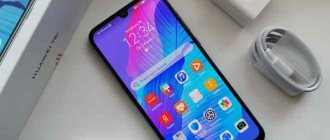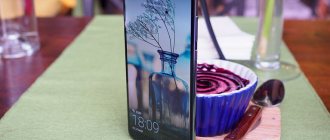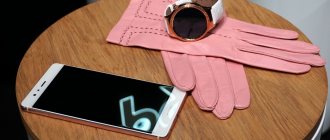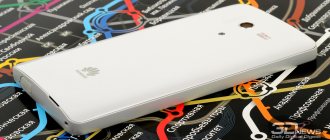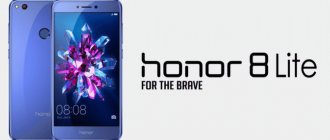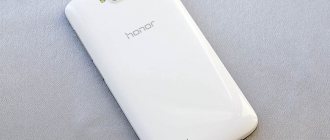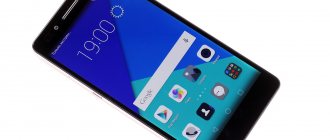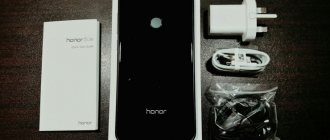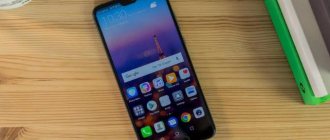Let's start with the good news. Huawei marketers have finally gotten rid of the completely unnecessary, rudimentary word Ascend in the names of their smartphones. It has outlived its usefulness – and that’s wonderful. Now the names of the Chinese company's smartphones sound succinct and concise. Compare for yourself which is better: Huawei Ascend P7 or Huawei P8/P8 Lite. The answer, in our opinion, is obvious: the shorter it is, the easier it is for everyone.
Now as for the new products from Huawei themselves. The first is a typical flagship. A large screen with Full HD resolution, a powerful eight-core processor, three gigabytes of RAM, support for advanced LTE standards, 13- and 8-megapixel cameras - this is not a complete list of the advantages of the Huawei P8. But we will talk about it in detail another time. Today we will talk about its younger brother – Huawei P8 Lite. It should be noted that Huawei has not previously spoiled us with various “mini” smartphones; this genre is new for the company. Therefore, it is very interesting to see how lumpy their first mini-pancake came out.
⇡#Technical characteristics
| Huawei Ascend P6 | Huawei Ascend P7 | Huawei P8 Lite | Huawei P8 | |
| Touch screen | 4.7 inches, 720 × 1280 pixels, IPS; Capacitive, up to 10 simultaneous touches | 5 inches, 1080 × 1920 pixels, IPS; Capacitive, up to 10 simultaneous touches | 5 inches, 720 × 1280 pixels, IPS; Capacitive, up to 10 simultaneous touches | 5.2 inches, 1080 × 1920 pixels, IPS; Capacitive, up to 10 simultaneous touches |
| Air gap | No | No | No | No |
| Oleophobic coating | Eat | Eat | Eat | Eat |
| Polarizing filter | Eat | Eat | Eat | Eat |
| CPU | Huawei HiSilicon K3V2E: Four cores ARM Cortex-A9 (ARMv7) frequency 1.5 GHz; Process technology 40 nm; 32-bit computing | Huawei HiSilicon Kirin 910T: Four cores ARM Cortex-A9 (ARMv7) frequency 1.8 GHz; Process technology 28 nm; 32-bit computing | Huawei HiSilicon Kirin 620: Eight cores ARM Cortex-A53 (ARMv8) Frequency 1.2 GHz; Process technology 28 nm; 32- and 64-bit computing | Huawei HiSilicon Kirin 930/935: Quad core ARM Cortex-A53 (ARMv8), 1.5 GHz; Four cores ARM Cortex-A53e (ARMv8), 2 GHz; ARM big.LITTLE technology; Process technology 28 nm; 32- and 64-bit computing |
| Graphics controller | Vivante GC4000 | ARM Mali-450 MP4, 533 MHz | ARM Mali-450 MP4, 533 MHz | ARM Mali-T628 MP4, 600 MHz |
| RAM | 2 GB | 2 GB | 2 GB | 3 GB |
| Flash memory | 8 GB + microSD | 16 GB + microSD | 16 GB + microSD | 32/64 GB + microSD |
| Connectors | 1 × micro-USB 2.0 1 × 3.5 mm headset jack 1 × microSD 1 × micro-SIM | 1 × micro-USB 2.0 1 × 3.5 mm headset jack 1 × microSD/micro-SIM 1 × micro-SIM | 1 × micro-USB 2.0 1 × 3.5 mm headset jack 1 × microSD/micro-SIM 1 × micro-SIM | 1 × micro-USB 2.0 1 × 3.5 mm headset jack 1 × microSD/nano-SIM 1 × nano-SIM |
| cellular | 2G/3G One SIM card in micro-SIM format | 2G/3G/4G Two SIM cards in micro-SIM format (the second cannot be installed when using a memory card) | 2G/3G/4G Two SIM cards in micro-SIM format (the second cannot be installed when using a memory card) | 2G/3G/4G Two SIM cards in micro-SIM format (the second cannot be installed when using a memory card) |
| Cellular connection 2G | GSM/GPRS/EDGE 850/900/1800/1900 MHz | GSM/GPRS/EDGE 850/900/1800/1900 MHz | GSM/GPRS/EDGE 850/900/1800/1900 MHz | GSM/GPRS/EDGE 850/900/1800/1900 MHz |
| Cellular 3G | HSPA+ (21 Mbps) WCDMA 850/900/1700/1900/2100 MHz | DC-HSPA+ (42 Mbps) WCDMA 850/900/1900/2100 MHz | DC-HSPA+ (42 Mbps) WCDMA 850/900/1900/2100 MHz | DC-HSPA+ (42 Mbps) WCDMA 850/900/1700/1900/2100 MHz |
| Cellular 4G | No | LTE Cat. 4 (150 Mbit/s) LTE band 1, 3, 7, 8, 20 (2100/1800/2600/900/800 MHz) | LTE Cat. 4 (150 Mbit/s) LTE band 1, 3, 7, 8, 20 (2100/1800/2600/900/800 MHz) | LTE Cat. 6 (300 Mbps) LTE band 1, 2, 3, 4, 5, 7, 8, 12, 17, 18, 19, 20, 25, 26, 28, 40 (2100/1900/1800/1700/850 / 2600/900/700/800/2300 MHz) |
| WiFi | 802.11b/g/n + Wi-Fi Direct | 802.11b/g/n + Wi-Fi Direct | 802.11b/g/n + Wi-Fi Direct | 802.11a/b/g/n + Wi-Fi Direct |
| Bluetooth | 4.0 | 4.0 | 4.0 | 4.1 |
| NFC | No | Eat | Eat | Eat |
| IR port | No | No | No | No |
| Navigation | GPS, A-GPS, GLONASS | GPS, A-GPS, GLONASS | GPS, A-GPS, GLONASS | GPS, A-GPS, GLONASS |
| Sensors | Illumination, proximity, accelerometer/gyroscope, magnetometer (digital compass) | Illumination, proximity, accelerometer/gyroscope, magnetometer (digital compass) | Illumination, proximity, accelerometer/gyroscope, magnetometer (digital compass) | Illumination, proximity, accelerometer/gyroscope, magnetometer (digital compass), pedometer |
| Main camera | 8 MP (3264 × 2448), back-illuminated matrix, autofocus, LED flash | 13 MP (4160 × 3120), back-illuminated matrix, autofocus, LED flash | 13 MP (4160 × 3120), back-illuminated matrix, autofocus, LED flash | 13 MP (4160 × 3120), back-illuminated matrix, autofocus, dual LED flash |
| Front-camera | 5 MP (2592 × 1952), no autofocus | 8 MP (3264 × 2448), no autofocus | 5 MP (2592 × 1952), no autofocus | 8 MP (3264 × 2448), no autofocus |
| Nutrition | Non-removable battery: 7.6 Wh (2000 mAh, 3.8 V) | Non-removable battery: 9.35 Wh (2460 mAh, 3.8 V) | Non-removable battery: 8.36 Wh (2200 mAh, 3.8 V) | Non-removable battery: 10.18 Wh (2680 mAh, 3.8 V) |
| Size | 133 × 65.5 mm Case thickness 6.2 mm | 140 × 69 mm Case thickness 6.5 mm | 143 × 71 mm Case thickness 7.7 mm | 145 × 72 mm Case thickness 6.4 mm |
| Weight | 120 g | 124 g | 131 g | 144 g |
| Water and dust protection | Absent | Absent | Absent | Absent |
| operating system | Android 4.2.2 Jelly Bean Emotion UI 1.6 shell | Android 4.4.2 KitKat Emotion UI 2.3 shell | Android 5.0 Lollipop Shell Emotion UI 3.1 | Android 5.0 Lollipop Shell Emotion UI 3.1 |
| recommended price | 15,990 rubles | 16,990 rubles | 17,990 rubles | Not announced |
| Huawei P8 Lite – information about the system and hardware according to the CPU-Z application | ||||
Judging by the technical specifications table, Huawei P8 Lite is in many ways inferior to its older brother. It looks like the engineers plucked off a piece (element) from the previous smartphones in the series, seasoned it with a new sauce (body) and served it to the table. The dish is ready, bon appetit! No, really, the combination of hardware is really strange - the smartphone has an HD-resolution display, an eight-core system-on-a-chip and a thirteen-megapixel camera. Let's try to figure out how all this coexists in one mid-price smartphone.
Operating system and shell
The shell uses EMUI 3.1, which is currently the latest version. The operating system is Android 5.0. An update to Android 6.0 Marshmallow is expected next year.
The EMUI 3.1 shell is very similar to MIUI and Flyme. In it, all applications are located on desktops. There is no application menu as such. It is possible to create folders, change the effect of flipping desktops and the grid of shortcuts.
The interface turned out to be interesting. For some, the downside will be that the system's shortcuts for popular applications look different from Google Play, but this is more a matter of habit. But the ability to change the location of the on-screen keys turned out to be a very useful feature. There is a “Themes” application. Most of them have a cartoon style. They change not only the wallpaper, but also shortcuts, dialer style and unlocking. Unfortunately, we couldn't find a Marshmallow or Lollipop theme.
Among the useful features, it is worth highlighting the “Movement” settings item. There are several tabs there. They allow you to configure how to mute an incoming call by turning the phone face down, as well as mute alarms and timers. You can also enable waking up the screen with a double tap.
⇡#Appearance and ergonomics
And Huawei marketers with a sense of humor are doing very well! Otherwise, it’s difficult to explain how it was possible to attribute the word Lite (“light”) to the plumpest and one of the heaviest smartphones in the line? Seriously, the body thickness of the P8 Lite is 7.7 millimeters, although the thickness of all Huawei P series gadgets still on sale does not exceed seven millimeters, and the newest ones are rapidly approaching six. The device also weighs noticeably – 131 grams. True, using the P8 Lite with one hand is quite convenient - you don’t get tired of it.
Huawei P8 Lite – front panel
Well, since we started to cut the truth, it’s worth saying that in the case of P8 Lite, the letter P in the name does not need to be deciphered as the pretentious Platinum. Be honest: here it obviously means Plastic. It is noteworthy that the body of the original P8 is made of metal.
Huawei P8 Lite – front panel
The device looks, to be honest, quite standard. There is nothing for the eye to catch on; it does not have any remarkable finishing elements. At the top of the front panel there is a slot for the earpiece and the lens of the front five-megapixel camera, at the bottom there is a rather large empty area. The system navigation keys – “Back”, “Home” and “Menu of open applications” – are touch sensitive, they are located at the bottom of the screen. The thickness of the side frames around the display is standard – neither large nor small.
Huawei P8 Lite – sides
Along all the narrow edges of the case there is a silver edging, stylized as metal - admittedly, a rather hackneyed solution, because of which the device looks somewhat cheap. Although Huawei P8 Lite is not a cheap smartphone.
Huawei P8 Lite – location of hardware keys
We have no comments regarding the ergonomics of the device. The power button and volume keys are on the right side, right under the thumb. The buttons have a short and distinct stroke; They are easy to use by touch. Next to them are slots for a Micro-SIM card and a universal connector for a SIM card or microSD flash drive. At the top end there is a headphone jack.
Huawei P8 Lite – bottom end
The Micro-USB 2.0 interface is located at the bottom end. Next to it are the slots for the external speaker. Its location is good - it does not overlap either during operation or when the smartphone is lying on the table.
Huawei P8 Lite – rear panel
The surface of the back panel of the device is rough, so it does not slip in your hands. At the top of the “back” there is the lens of the main thirteen-megapixel camera along with an LED flash.
⇡#Display
The smartphone has a five-inch IPS screen with a resolution of 720 × 1280 pixels. To be honest, for a modern smartphone released in mid-2015, this is a very small resolution - it will hardly surprise anyone. The pixel density of the screen is quite decent - 293.7 ppi. Individual pixels are not visible to the naked eye, the “pixelization” effect is moderate. Small fonts lack sharpness a little, but movies and photographs look quite detailed. The resolution is sufficient for multimedia tasks and games.
You can look at the screen from any angle – the information on it remains readable even at large viewing angles. Thanks to this, it is convenient to watch movies on the device together. True, a barely noticeable purple tint appears on black, but this does not interfere with working with the device. The touch screen is quite responsive – it responds very quickly and accurately to touches and recognizes gestures. In total, the display understands up to ten simultaneous presses.
Huawei P8 Lite – AnTuTu MutliTouch Test results
The screen was made, as they say, with due philanthropy. A very effective polarizing filter combats glare here. Protective glass with an oleophobic coating is used, thanks to which the surface of the front panel is easily cleaned from “fingers” and other small dirt. In addition, there is no air gap between the protective glass and the matrix - the screen is made using OGS technology. This has a positive effect on the number of unwanted reflections.
The brightness reserve of the Huawei P8 Lite screen is moderate. The maximum luminosity of the white field is 307 cd/m2. By modern standards, this is not so much. In direct sunlight, the display noticeably fades - you have to squint and raise the backlight level to maximum to see what is happening on it. But for well-lit rooms the brightness is quite enough. The minimum screen brightness is only 12 cd/m2, which means that in the dark the device is very gentle on your eyes. The gadget is equipped with a light sensor, thanks to which it can automatically change the display backlight level for comfortable work in certain conditions.
The display is not very contrasty: the contrast ratio is 746:1, and this is not very good. It’s not critical at all, but it’s not good either – about a four minus on a five-point scale. Modern IPS-ki boast 1000:1.
The color temperature of dark shades of gray is on average 7250 K. When moving to light colors, it begins to increase noticeably. So, the white temperature is 7750 K, which is a bit too much. Let us remind you that the ideal value is considered to be 6500 K, but the picture on the Huawei P8 Lite display looks “cold”. It is noteworthy that the shell provides the ability to adjust the white balance, so that if necessary, the colors on the screen can be made “warmer”.
Huawei P8 Lite – adjusting color temperature
The display, on the contrary, is calibrated very well, almost wonderful. All gamma curves – both color components and gray – almost completely coincide with the reference curve. This means that the midtones on the P8 Lite's display are exactly as bright as they should be - neither dimmer nor brighter. Minimal deviations can be safely neglected. The scales are very, very decent.
The triangle with the display's color gamut is slightly irregular in shape. Judging by the diagram, blue and green are slightly oversaturated, and red, on the contrary, is slightly dimmer than it should be. However, the deviations are also not at all critical. In general, the display is configured normally.
Huawei P8 Lite – smartphone screen color gamut (white triangle) compared to sRGB color space (black triangle)
Screen
HUAWEI P8 Lite is equipped with a 5-inch IPS screen with HD resolution (1280×720). PPI is 294. There is automatic brightness adjustment and ophleophobic coating. The quality of the coverage is average. The maximum brightness is 316 cd/m², and the minimum is 9.7 cd/m². The contrast is 1 in 505. It is quite difficult to work with the phone under direct sunlight - low brightness and contrast affect it.
Screen measurements showed the following. The color temperature is smooth and is at the level of 6500K, which is the reference value. From other graphs it is clear that green color predominates over the rest.
As a result, the screen has no obvious shortcomings. A little contrast and brightness spoil the picture, but in this price range this is not so critical. You need to remember that in the screen settings menu there is a “Color Temperature” item that allows you to adjust the screen temperature to suit you. This is very convenient, as some people like cooler colors, while others want warmer ones. In this regard, HUAWEI decided not to limit the user, which is correct.
⇡#Hardware and performance
The Huawei P8 Lite has a new, and therefore especially interesting for us, HiSilicon Kirin 620 system-on-chip. Yes, Huawei continues to use its own platforms in its gadgets (more precisely, its subsidiary). The system-on-chip used is eight-core. But this is good only for the company’s marketers and for users who do not clearly understand that the kernels are different. The fact is that the Kirin 620 includes eight ARM Cortex-A53 cores operating at a frequency of 1.2 GHz. As we know, these cores are not very productive, and how they will solve complex problems when gathered in a group of eight is an open question.
It is noteworthy that these processor cores are capable of executing the modern ARMv8 instruction set, thanks to which the chip supports 64-bit computing. The platform's process technology is quite old - 28 nm HPm, while many competitors are already using 20 nm or even smaller design standards.
The role of the graphics controller in the Kirin 620 is played by the ARM Mali-450 MP4, operating at a frequency of 533 MHz. There are more advanced GPUs on the market, but for a system-on-a-chip in the mid-price category, this one will do just fine. The device has two gigabytes of RAM, which is enough to perform everyday tasks and run most games. The volume of built-in flash memory is fixed - 16 gigabytes; there are no versions with a larger volume. If necessary, the user can install a microSD memory card with a capacity of up to 64 gigabytes into the device instead of a second SIM card - the slot is universal.
In synthetic tests, the device showed completely standard results for its class. So, in the AnTuTu Benchmark 5 task, the gadget scored thirty-five thousand “parrots”, in the simple game Basemark 2 Taiji - 55.3 FPS. Overall acceptable, but without any complaints.
With “difficult” game tasks, things are somewhat worse. “Heavy” games on the P8 Lite noticeably slow down - the number of frames per second often drops below a comfortable thirty per second. In 3DMark Ice Storm Unlimited and GFX Bench 3, the gadget could not keep up even with the LG G3 and Fly Tornado Slim - far from the most gaming “devices”.
⇡#Communication
Working with two SIM cards in Huawei P8 Lite is implemented in a completely standard and, perhaps, the most convenient way. After installing the cards in the slots, the user must determine which of them to access the network, which to make calls, and which to send SMS and MMS messages. The log of messages and calls shows which SIM was active - you won’t be able to get confused in the cards. Talking through the device is quite convenient: the volume reserve of the earpiece is decent, and the interlocutors did not complain about poor audibility. In general, the device copes with its main task well.
| Huawei P8 Lite – AndroiTS GPS Test results outdoors | ||
The set of wireless interfaces on the smartphone is completely standard. There is Wi-Fi, Bluetooth and NFC. The gadget navigates the area using a radio module that communicates with GPS satellites (with support for A-GPS hot start technology) and GLONASS. It works quite stably. A minute after launching the profile test, the gadget detected a total of twelve satellites of two navigation systems and was guided by seven of them. The navigation error radius was in the region of 11-13 meters, which is quite acceptable. During testing, the device was quite successfully used as the only means of communication, access to the Internet and navigation - we have no complaints about the radio modules.
Sound
Huawei P8 Lite 2021 dual sim review shows that the external speaker boasts a large volume reserve. The quality of music playback did not disappoint, the only thing was that it was located in a less than ideal place. During the game, it is easily blocked by the palm, muffling the sound. The speaker transmits the voice of the interlocutor without distortion, the volume margin is acceptable. The microphone also does its job well. Music sounds good in the headset, and it will be comfortable to listen to it at half the volume, provided you use high-quality headphones.
⇡#Camera
The front camera in the device is five megapixel. It doesn’t have autofocus, and, of course, it doesn’t have a flash either. With its help, you can take good self-portraits and organize video conferences even in moderate lighting. There is no shame in uploading selfies to social networks from the front camera of the P8 Lite. In the dark, the picture becomes quite noisy, in general, like all webcams.
Huawei P8 Lite – main camera
The main camera here is also quite serious - with a 13 megapixel BSI backlight sensor, an automatic focus system and an LED flash. The camera control interface is very simple and easy to understand. There is an HDR mode, depth of field control, automatic selection of the best photo from a series, automatic enhancement of portraits, voice shooting, a number of artistic filters, geotags and other standard options for digital cameras. You can judge the quality of the shooting from the photographs below.
Huawei P8 Lite
View all images (0)
The camera definitely takes good pictures - no worse than the cameras of “classmates”. In bright daylight, photos turn out rich, with natural colors and a good level of detail. Sharpness drops slightly towards the corners of the frame, but not critically. Indoors, contrast and detail decrease slightly, but are still very decent. The Huawei P8 Lite camera copes with shooting in the dark like most other mobile cameras - with varying, to put it mildly, success.
Huawei P8 Lite camera review
Huawei P8 Lite white dual sim review moves on to the cameras, in which we did not find any significant changes. The main module uses the already familiar 13 MP Sony IMX 214 sensor, which we have seen in previous generations of the smartphone. In the hands of a skilled photographer, you can expect decent images, but the quality of the images is greatly influenced by lighting conditions.
Example photo on Huawei P8 Lite
The standard application has a huge number of settings that the average user can easily get lost in. Shooting can be done in HDR mode, which enhances the illumination of objects located in the shadows. The Huawei Honor P8 lite review showed that you can take audio notes from photos, add a watermark, take burst shots and take colorful panoramas of the area. Both the main and front cameras received a facial skin enhancement mode, when visual imperfections, including acne, are smoothed out.
In good lighting conditions, high-quality images are obtained, although noise appears when enlarged. When shooting at night, you have to freeze for a few seconds to get a really good shot, but it's worth it.
The wide-angle front camera with a resolution of 5 MP can record video in FullHD format. You can get decent selfies with it if you shoot in good lighting conditions.
Conclusion
Huawei P8 lite deserves attention among those who value, above all, the practicality of the case and its design. But besides this, the smartphone has something to offer - an excellent camera, a user-friendly interface, good hardware and clear images on the display. At the same time, the brightness reserve and contrast of the screen are disappointing; it would be a good idea to increase the battery capacity.
Where can I buy?
Following the links you can buy a smartphone at the best prices:
Aliexpress
Comments for the site
Cackl e
Review of Huawei Honor 9 Lite - what did you have to sacrifice to significantly reduce the price of the flagship?
Honor 8 Lite is a great option for its price
Huawei Y3 II - review of a budget phone from a leading Chinese manufacturer
Huawei P20 Lite - review of the lightweight version of the flagship
Huawei Mate 10 Lite review - a simplified version of the flagship that has a lot to offer
Huawei Honor 3C is a modern smartphone with excellent characteristics
Huawei P10 is one of the best offerings from the manufacturer, which, with the exception of a couple of minor flaws, turned out to be perfect
Huawei Honor 6C Pro is a bright representative of the budget category
Huawei Nova 2 is a smartphone whose main feature is its cameras
Huawei Honor 5c - review, price and specifications
Huawei P9 Lite - they offer us a simplified version of the flagship at a tasty price. Let's find out if everything is really that good.
⇡#Autonomous work
The device has a rather modest battery with a capacity of 8.36 Wh (2200 mAh, 3.8 V). It should be noted that even the previous Ascend P7 was equipped with a fatter battery – 2460 mAh. It is not clear what is causing the reduction in capacity; it seems that the P8 Lite has a larger body, a newer generation, and a smaller battery. Not good.
With continuous video playback and data updating in the background, the device lasted just over six hours. In general, the result is acceptable, but some competitors “live” in this test even longer. Obviously, to extend battery life, it is enough to lower the screen backlight level and turn off unused wireless modules. During testing, the device only failed to survive until the end of the working day once, when it was used almost without interruption as a car navigator. The average operating time of the P8 Lite is quite standard - from a working day to a day, depending on the load.
| Huawei P8 Lite – Power Consumption Settings | ||
As is usually the case, the device has several energy saving modes. By default, the “normal” scenario is activated, in which the electronics do not greatly limit the CPU load. There is also a “smart” mode in which the device tries to use fewer platform cores. Finally, the “energy-saving” mode comes in handy when the battery charge is low and you can’t remain without communication. In this mode, all “smart” functions are disabled, and a wonderful smartphone turns into a very ordinary mobile phone with a notebook and SMS/MMS transfer function.
Autonomy
The smartphone is equipped with a non-removable battery with a capacity of 2200 mAh. You shouldn’t expect a long operating time from such a modest battery; practice has confirmed our fears.
If desired, and under heavy loads in the form of games, watching videos and surfing the 3G network, the device will last through daylight hours. If you moderate your ardor, you can count on a day of battery life.
